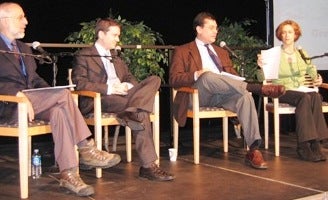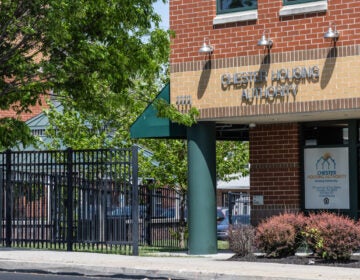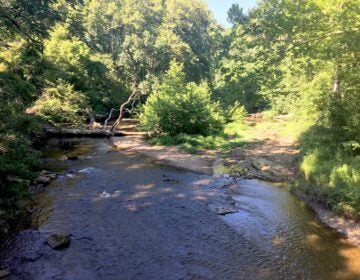Talk on NYC waterfront planning

Harris Sokoloff, Howard Slatkin, Harris Steinberg, Janice Woodcock
Jan. 8, 2007
Howard Slatkin, an expert in urban land use with the New York City Planning Commission, spoke for an hour to the Central Waterfront Advisory Group and the public about the years-long process New York City used to reinvent and reinvigorate two miles of East River waterfront in Greenpoint-Williamsburg.
The presentation, attended by close to one hundred people, followed the regular meeting of the advisory group and was held at the WHYY Independence Foundation Civic Space, 150 North 6th Street.
The talk will be part of a program aired digitally by WHYY. Click here for more information.
Slatkin’s power-point assisted discussion focused on what New York City has done and is still envisioning for Greenpoint-Williamsburg. In November, the advisory group attended a presentation by Slatkin about the issues of scale of construction, affordable housing incentives, public access and the establishment of parks and open spaces in the Brooklyn neighborhoods that are only one transit stop from Central Manhattan.
Monday morning, Slatkin pointed out how New York approached the plan, which was adopted in May 2005, by seeking crucial public interaction and recognizing that the planning process would have to appreciate the required balancing act between multiple uses on common sites.
Although the issues that accompany the reality of maintaining a working port that employs 45,000 people and the problem of working around an on-site superhighway did not exist in the Greenpoint-Williamsburg project, Slatkin was able to point out many nuances in the New York planning process that can be considered and even replicated as the Central Delaware project moves through various stages of civic and expert engagement.
“It is important to reflect upon what you saw here, what lessons we may have learned, what ideas do we take from this to help us shape our plan,” said Harris Steinberg of PennPraxis, the lead consultant in developing a new vision for the Delaware River waterfront. “Many parts of what happened in New York, and what is still happening, should resonate with our our plans for the Delaware River, where whatever designs occur will have to respond to the needs of specific neighborhoods. The Greenpoint-Williamsburg work is quite applicable to what we will be doing.”
Slatkin pointed out that much of the Greenpoint-Williamsburg waterfront was completely inaccessible to the public and privately owned so that the only feasible way to create and maintain a public realm was to find a way to integrate development with the pubic’s vision for their neighborhoods and riverfront.
Although the project encompasses 184 blocks and about two miles of East River waterfront, a scope that is quite a bit smaller than the Central Delaware process, Slatkin pointed out that the community interaction in the process dates back 10 years and that certain waterfront design principles that grew out of the public discourse are essential.
“We knew that we had to value certain elements, such as reconnecting the neighborhoods to the waterfront; keeping the scale of construction low rise at the water’s edge; creating a varied and compelling skyline; making the streetscpae pedestrian friendly; accomodating water-based transportation; and blending zoning to accomodate, industry, residential and affordable housing as well as recreation,” Slatkin said.
A video record of the presentation will be available later Monday.
Slatkin, 33, is a Team Leader with the Department of City Planning. In addition to a role in implementation of the Greenpoint-Williamsburg plan, and other planning projects on and near the Brooklyn waterfront, he is also the Department’s coordinator for its recently expanded Inclusionary Housing program.
He received his master’s degree in Urban Planning from Columbia University, and a bachelor’s degree from Brown University.
Click on the NYC Planning Commission report for the Greenpoint-Williamsburg project
WHYY is your source for fact-based, in-depth journalism and information. As a nonprofit organization, we rely on financial support from readers like you. Please give today.






